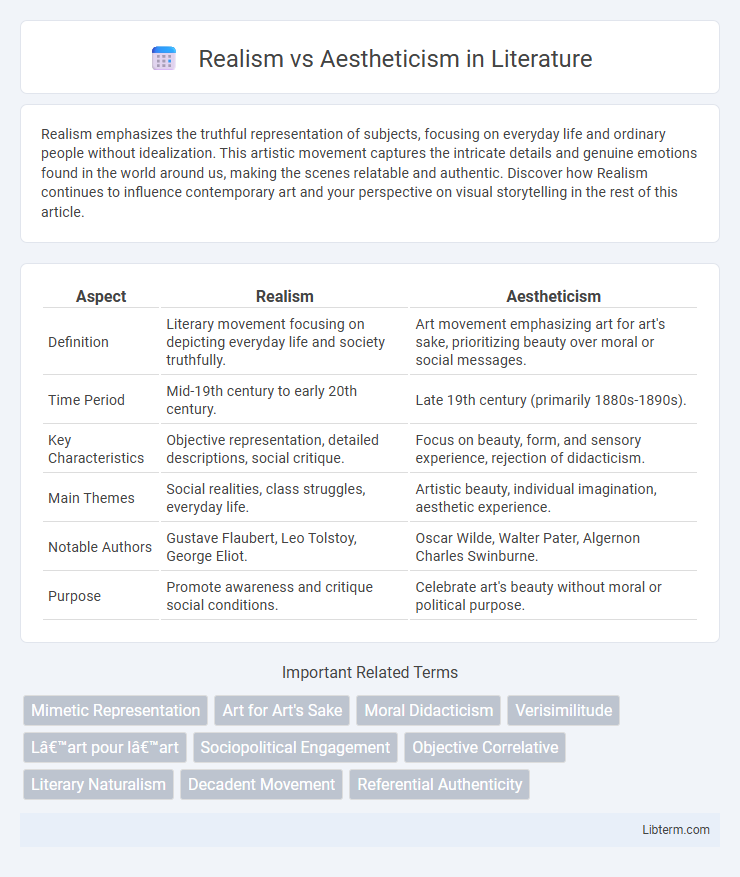Realism emphasizes the truthful representation of subjects, focusing on everyday life and ordinary people without idealization. This artistic movement captures the intricate details and genuine emotions found in the world around us, making the scenes relatable and authentic. Discover how Realism continues to influence contemporary art and your perspective on visual storytelling in the rest of this article.
Table of Comparison
| Aspect | Realism | Aestheticism |
|---|---|---|
| Definition | Literary movement focusing on depicting everyday life and society truthfully. | Art movement emphasizing art for art's sake, prioritizing beauty over moral or social messages. |
| Time Period | Mid-19th century to early 20th century. | Late 19th century (primarily 1880s-1890s). |
| Key Characteristics | Objective representation, detailed descriptions, social critique. | Focus on beauty, form, and sensory experience, rejection of didacticism. |
| Main Themes | Social realities, class struggles, everyday life. | Artistic beauty, individual imagination, aesthetic experience. |
| Notable Authors | Gustave Flaubert, Leo Tolstoy, George Eliot. | Oscar Wilde, Walter Pater, Algernon Charles Swinburne. |
| Purpose | Promote awareness and critique social conditions. | Celebrate art's beauty without moral or political purpose. |
Introduction to Realism and Aestheticism
Realism, emerging in the mid-19th century, emphasizes accurate, detailed, and unembellished depiction of everyday life, prioritizing objective representation over idealization. Aestheticism, rising in the late 19th century, advocates for "art for art's sake," valuing beauty and sensory experience above moral or social themes. These contrasting movements shaped literature and visual arts by defining the purpose of art either as truthful reflection or as pursuit of aesthetic pleasure.
Historical Contexts: Origins and Development
Realism emerged in the mid-19th century as a reaction against Romanticism, emphasizing accurate depictions of everyday life and social conditions during the Industrial Revolution. Aestheticism developed in the late 19th century, particularly in Victorian England, advocating for "art for art's sake" and prioritizing beauty and sensory experience over moral or social themes. Both movements reflect distinct responses to the cultural and historical shifts of their time, with Realism rooted in social critique and Aestheticism highlighting individual artistic expression.
Key Philosophical Foundations
Realism emphasizes the faithful representation of reality, grounded in the belief that art should depict life accurately and objectively, reflecting observable truth and social conditions. Aestheticism prioritizes beauty and sensory experience, asserting that art's value lies in its form and emotional impact rather than moral or social messages. The philosophical foundations of Realism stem from empirical observation and social critique, while Aestheticism derives from the concept of "art for art's sake," focusing on individual perception and artistic autonomy.
Major Figures and Their Contributions
Realism found prominent advocates in Gustave Flaubert, whose meticulous depiction of everyday life in "Madame Bovary" emphasized objective reality, and Honore de Balzac, known for his comprehensive "La Comedie Humaine" series that detailed French society with psychological depth. Aestheticism, championed by Oscar Wilde, celebrated "art for art's sake" through works like "The Picture of Dorian Gray," emphasizing beauty and sensory experiences over moral or social commentary. These major figures shaped their movements by defining the tension between truthful representation and the pursuit of beauty as art's primary purpose.
Core Principles of Realism
Realism emphasizes accurate, detailed representation of everyday life, prioritizing objectivity and truthful depiction over idealization or romanticism. Core principles include a focus on ordinary characters, social conditions, and plausible events that reflect real-world experiences. This approach contrasts with Aestheticism's celebration of beauty and art for art's sake, as Realism grounds artistic expression in ethical and social realities.
Defining Features of Aestheticism
Aestheticism emphasizes art for art's sake, prioritizing beauty, sensory experience, and individual expression over moral or social themes. It champions intricate detail, vibrant color, and ornamental style, often rejecting utilitarian or didactic functions in artistic creation. This movement contrasts with Realism by focusing on imaginative idealization rather than objective representation of everyday life.
Realism vs Aestheticism in Literature
Realism in literature emphasizes accurate, detailed depictions of everyday life and society, often focusing on ordinary characters and social issues to reflect reality truthfully. Aestheticism, by contrast, values beauty and artistic expression over moral or social themes, prioritizing style, sensory experience, and the pursuit of art for art's sake. The tension between Realism's commitment to truthful representation and Aestheticism's focus on beauty highlights differing literary approaches to truth, purpose, and the role of art.
Impact on Art and Visual Culture
Realism revolutionized art by emphasizing accurate, detailed depictions of everyday life, influencing the rise of photography and shaping social commentary through visual culture. Aestheticism, prioritizing beauty and sensory experience over narrative or moral content, challenged traditional art norms, promoting art for art's sake and inspiring movements like Art Nouveau. Both movements significantly impacted visual culture by redefining artistic purpose: Realism grounded art in observable reality, while Aestheticism elevated aesthetic values, expanding creative expression and audience perception.
Criticisms and Debates
Realism faces criticism for its sometimes harsh depiction of everyday life, which detractors argue limits artistic imagination and emotional depth. Aestheticism is debated for prioritizing beauty and form over moral or social messages, prompting concerns that it may neglect meaningful content. These opposing views fuel ongoing discussions about the purpose of art, balancing truth and beauty in literary and artistic expression.
Contemporary Relevance and Influence
Realism maintains contemporary relevance by grounding art and literature in everyday experiences, addressing social issues and fostering empathetic understanding in modern audiences. Aestheticism influences contemporary culture through its emphasis on beauty and sensory experience, shaping design, fashion, and digital media with an enduring focus on artistic form over moral or political content. Both movements continue to inform creative expression, balancing meaningful representation and aesthetic innovation in today's diverse artistic landscape.
Realism Infographic

 libterm.com
libterm.com